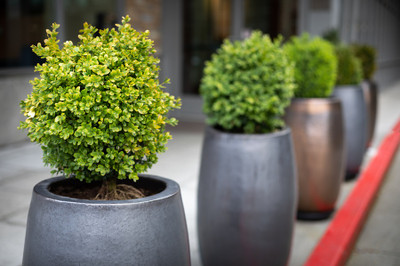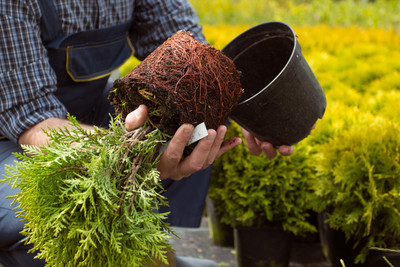Our Tips for Choosing the Best Color Pots and Planters
Posted by Jason Wyrwicz on Oct 14th 2022
Whether your pots or planters are indoors or outdoors, color selection plays a big part in how your plants thrive and the vibe they bring to the environment. In this article, we will share our knowledge of color theory from a design perspective and how plants react to pots with lighter and darker hues. We hope it gives you some food for thought when designing your next space!
How do plants react to colored pots?
Before we get into aesthetics, we should talk about plant growth because, as you know, it doesn't matter how beautiful the finish on your pot or planter is. If the plant doesn't grow well, there is not much point in having them in the first place!
The most significant factor in how plants react to planter color is its propensity to retain heat. In an outdoor setting, darker-colored pots will absorb more sunlight and retain heat longer than light-colored ones. It is essential to understand the climate conditions of your location when selecting the type of color you want. That said, indoor environments mirror outdoor conditions, especially if plants are nearby windows or glass doors.
The direct implication for container color hinges on soil temperature and how that affects the roots of your chosen plant. Soil temperatures on sun-facing containers are highest in black pots and lower in lighter-colored pots. Some plants can withstand conditions despite the color of the pots or planters, whereas others are heat-sensitive and will not tolerate containers that amplify ambient temperature.
An excellent way to think about how pot color affects plants is to think about how the roof of your home reflects or absorbs heat from the sun's rays. Darker-colored rooftops suck in heat and transfer it into the house, whereas lighter-colored roofs deflect that heat, keeping the internal temperature lower.
The overall result is that heat stress is plants can't germinate, fruit or flower. The most catastrophic scenario is that they can wither and die
Do pots and planters affect aesthetics?
Aside from the health of plants, buyers must consider how the color of planters and pots bring emotion, distinction, and harmony into a room. Different colors evoke different messages, depending on the location, such as a home, office, or outdoor setting.
Plant pots can blend into the room or become a stunning centerpiece, promoting a topic of conversation and creating emotions that embolden, intrigue, or encourage harmony. Interior designers have used color theory in commercial and residential properties for years to catch the eye, make a statement or reinforce brand identity.
So let's discuss particular pot and planter colors and how they affect plants and the rooms they occupy.
Brown/Beige
Brown and beige are more neutral, earthy tones that can be paired with almost any other interior or exterior design elements. As they are the same color as the soil and bark inside the pot, they become a significant extension of the plant itself.
Because they reflect enough sunlight, the soil doesn’t become too warm, so the plants have good conditions to grow.
White
White containers are the go-to option for a minimalist feel that contrast more striking design elements—predominantly black. Associated with sterility and cleanliness, white pots and planters promote a more modern look than other colors.
Obviously, white reflects light, so the soil inside stays damper and cooler for longer. Depending on the plant's watering requirements, white containers can be a great choice when placed in areas of direct sunlight.
Black
Dramatic, sleek, striking. Black pots and planters immediately draw attention when paired with more neutral colors. Depending on your preferences, it is essential to know that too many black elements can evoke feelings of depression and morbidity, so try not to go overboard! Black design elements can also make rooms feel smaller, so try using them in more expansive, open spaces such as lobbies, open-plan kitchen/dining areas, and meeting rooms.
When juxtaposed with white planters, black works better in indoor environments out of direct sunlight due to their propensity to absorb heat, causing root damage from drier soil.
Gray
In the design world, gray is becoming much more popular due to its use in ‘industrial-themed’ environments. Neutral in nature, gray pots or planters can give off a similar vibe to beige but without the warming feeling.
Depending on the hue, gray pots and planters retain heat differently. Where lighter grays reflect light better, darker versions suck in more heat. Testing out different plants with different types of gray planters is recommended.
Blue/Green
When interior and landscape designers use blue and green pots and planters, they intend to give residents the calming feeling of the sea and sky. When used indoors, these colors bring nature into your home or office. Greens specifically allow the plant to flow towards its container, while blues offer a nice contrast often found in nature,
Emphasizing the soil issue, these colors are generally darker and absorb more sunlight, thus increasing soil temperature, so using them outside must be implemented judiciously.
Yellow
Ahhhh, the feeling of summertime! Yellow planters are striking and make people smile. When using this vibrant color, you cannot help but think of warm days, sunflowers, daffodils, and holidays. Yellow containers also pair well with darker varieties, offering a striking tone in any room or garden space. You can combine these pots with darker colors such as green and purple to help liven up your garden space.
Red and Pink
Eccentricity at its finest. Red and pink pots and planters give spaces an eclectic feel that gives visitors an idea of your outgoing personality. Red especially has a romantic feel that works well in a restaurant environment, where the lighting is darker.
While red warms the soil a little more than lighter colors, pink is pretty neutral and can be placed outdoors with less concern for the plant's wellbeing in your indoor or garden setting.
We hope this blog has given you some food for thought when choosing what color pots and planters to use. Whether you are trying to create a certain mood, or are more focused on the growth and health of your plants, PPM have a wide variety of options at your fingertips. Check us out!



